Preparation, Characterization, and In Vitro Evaluation of the Biological Activity of Several Metal-Based Complexes with Two Widely Used Fluoroquinolone Antibiotics: Lomefloxacin and Pefloxacin Drugs
Abstract
:1. Introduction
- (1)
- Synthesizing four metal-based complexes of F1 and F2 with Mg(II), Ca(II), Zn(II), and Fe(III) ions. The parameters of preparation were as follows: solvent—H2O:meoh (1:1), reaction temperature—60–70 °C, media—neutral (ph 7–8), and molar ratio—1:1 (ligand to ion).
- (2)
- Employing several physicochemical approaches, including CHN elemental analyzer, ultraviolet/visible (UV-visible), Fourier-transform infrared (FT-IR), and nuclear magnetic resonance (1H NMR) spectroscopies, to explore the complexation mode of F1 and F2 toward the metal ions under investigation.
- (3)
- Observing the surface morphology, phase purity, shapes, and sizes of the synthesized complexes’ particles using scanning and transmission electron microscopy (SEM and TEM, respectively) and X-ray powder diffractometry (XRD).
- (4)
- Screening the synthesized metal-based complexes in vitro for their antimicrobial properties using the Kirby–Bauer disc diffusion assay method. The investigated microbes were Bacillus subtilis, Streptococcus pneumoniae, Staphylococcus aureus, Escherichia coli, and Pseudomonas aeruginosa, as well as three fungal microbes (Aspergillus niger, Penicillium sp., and Candida albicans).
2. Materials and Methods
2.1. Materials
- (i)
- Mg(II): MgCl2 (95.21 g/mol; purity ≥ 98%);
- (ii)
- Ca(II): CaCl2 (110.98 g/mol; purity 99.99%);
- (iii)
- Zn(II): ZnCl2 (136.30 g/mol; purity ≥ 99.99 %);
- (iv)
- Fe(III): FeCl3·6H2O (270.30 g/mol; purity ≥ 98%);
- (v)
- F1: Lomefloxacin as HCl salt (C17H19F2N3O3⋅HCl; 387.81 g/mol; purity ≥ 98%);
- (vi)
- F2: Pefloxacin as mesylate salt (C17H20FN3O3⋅CH4O3S⋅2H2O; 465.49 g/mol; purity ≥ 98%).
2.2. Synthetic Methods
2.3. Characterization Methods
2.4. Antimicrobial Assays
3. Results and Discussion
3.1. Compositions and UV-Visible Spectra
3.2. FT-IR Spectra
3.2.1. Complexes of F1
- (i)
- A strong, broad absorption band with a single head appeared at 3438 cm−1. This broadband could be assigned to the ν(O−H) vibrations of −the COOH group in the molecule and to moisture water.
- (ii)
- A medium-intensity absorption band resonated at 2938 cm−1, and this band could be referred to as the ν(N−H)piperazine vibrations [25].
- (iii)
- A strong board absorption band in the region from 2900 to 2600 cm−1 with multi-heads. These heads had different intensities and were located at 2892, 2841, 2760, 2703, and 2660 cm−1. All these heads originated from νasym(C−H) and νsym(C−H) vibrations of CH, CH3, and CH2 moieties.
- (iv)
- A group of three very strong and sharp absorption bands resonated at 1724, 1620, and 1492 cm−1. The band at 1492 cm−1 had a shoulder band with medium intensity located at 1529 cm−1. The bands at 1719 and 1625 cm−1 were generated from the ν(C=O)COOH and ν(C=O)pyridone vibrations, respectively. The band at 1492 cm−1 was due to the δdef(CH2) vibrations, whereas its shoulder at 1529 cm−1 could be referred to as the ν(C=C) vibrations [26].
- (v)
- A group of medium-intensity bands resonated at 1333, 1257, 1212, 1096, 1042, and 807 cm−1 were generated from the vibrations of δsciss(CH2), νasym(C−N), ν(C−O), ν(C−F), νsym(C−N), and δwag(CH3), respectively [27].
3.2.2. Complexes of F2
- (i)
- A strong, broad absorption band with a single head appeared at 3450 cm−1, originating from the vibrations of the O−H bond of −the COOH group in the molecule and moisture water.
- (ii)
- A medium-intensity board absorption band with three heads appeared at 3055, 2985, and 2930 cm−1. These heads were due to the νasym(C−H) and νsym(C−H) vibrations of CH, CH3, and CH2 moieties.
- (iii)
- A strong, board absorption band in the region from 2700 to 2400 cm−1 with three heads. These heads had different intensities and resonated at 2647, 2578, and 2454 cm−1. This broad band could be assigned to the ν(NH+)−CH3 vibrations.
- (iv)
- A group of three strong and sharp absorption bands located at 1715, 1635, and 1486 cm−1. The band at 1486 cm−1 had a medium-intensity shoulder band located at 1518 cm−1. The absorptions at 1715, 1635, 1518, and 1486 cm−1 were due to the ν(C=O)COOH, ν(C=O)pyridone, ν(C=C), and δdef(CH2) vibrations, respectively [26].
- (v)
- Absorptions at 1405, 1273, 1202, 1093, and 1053 cm−1 had different intensities and could be referred to as the vibrations of δsciss(CH2), νasym(C−N), ν(C−O), ν(C−F), and νsym(C−N), respectively [27].
3.2.3. H NMR Spectral Analysis
3.3. Proposed Structures
3.4. XRD, SEM, and TEM Results
3.5. Biological Screening
3.5.1. Antibacterial Activity
- (a)
- Screening toward gram-positive bacteria
- (b)
- Screening toward gram-negative bacteria
3.5.2. Antifungal Activity
4. Conclusions
Author Contributions
Funding
Data Availability Statement
Acknowledgments
Conflicts of Interest
References
- Tella, A.C.; Obaleye, J.A.; Olawale, M.D.; Ngororabanga, J.M.V.; Ogunlaja, A.S.; Bourned, S.A. Synthesis, crystal structure, and density functional theory study of a zinc(II) complex containing terpyridine and pyridine-2,6-dicarboxylic acid ligands: Analysis of the interactions with amoxicillin. Comptes Rendus Chimie 2019, 22, 3–12. [Google Scholar] [CrossRef]
- Eichhorn, G.L.; Marzilli, L.G. Advances in Inorganic Biochemistry Models in Inorganic Chemistry; PTR Prentice-Hall, Inc.: Englewood Cliffs, NJ, USA, 1994. [Google Scholar]
- Hughes, M.N. The Inorganic Chemistry of Biological Processes, 2nd ed.; Wiley: Chichester, UK, 1984. [Google Scholar]
- Alessio, E. Bioinorganic Medicinal Chemistry; Wiley-VCH Verlag GmbH and Co. KGaA: Weinheim, Germany, 2011. [Google Scholar]
- FTrudu; Amato, F.; Vaňhara, P.; Pivetta, T.; Peña-Méndez, E.M.; Havel, J. Coordination compounds in cancer: Past, present and perspectives. J. Appl. Biomed. 2015, 13, 79. [Google Scholar]
- Singh, U.; Malla, A.M.; Bhat, I.A.; Ahmad, A.; Bukhari, M.N.; Bhat, S.; Anayutullah, S.; Hashmi, A.A. Synthesis, molecular docking and evaluation of antifungal activity of Ni(II),Co(II) and Cu(II) complexes of porphyrin core macromolecular ligand. Microb. Pathog. 2016, 93, 172. [Google Scholar] [CrossRef] [PubMed]
- Netalkar, P.P.; Netalkar, S.P.; Revankar, V.K. Transition metal complexes of thiosemicarbazone: Synthesis, structures and invitro antimicrobial studies. Polyhedron 2015, 100, 215. [Google Scholar] [CrossRef]
- Ragheb, M.A.; Eldesouki, M.A.; Mohamed, M.S. DNA binding, photo-induced DNA cleavage and cytotoxicity studies of lomefloxacin and its transition metal complexes. Spectrochim. Acta A 2015, 138, 585. [Google Scholar] [CrossRef]
- Sana, S.S.; Hou, T.; Li, H.; Vadde, R.; Basavegowda, N.; Chakravorty, A.; Kumbhakar, D.V.; Zhang, Z.; Mamidi, N. Crude Polysaccharide Produces Silver Nanoparticles with Inherent Antioxidant and Antibacterial Activity. ChemistrySelect 2023, 8, e202203658. [Google Scholar] [CrossRef]
- Tabassum, Z.; Mohan, A.; Mamidi, N.; Khosla, A.; Kumar, A.; Solanki, P.R.; Malik, T.; Girdhar, M. Recent trends in nanocomposite packaging films utilising waste generated biopolymers: Industrial symbiosis and its implication in sustainability. IET Nanobiotechnol. 2023, 17, 127–153. [Google Scholar] [CrossRef]
- Sana, S.S.; Vadde, R.; Kumar, R.; Arla, S.K.; Somala, A.R.; Rao, K.K.; Zhijun, Z.; Boya, V.K.N.; Mondal, K.; Mamidi, N. Eco-friendly and facile production of antibacterial zinc oxide nanoparticles from Grewia flavescens (G. flavescens) leaf extract for biomedical applications. J. Drug Deliv. Sci. Technol. 2023, 80, 104186. [Google Scholar] [CrossRef]
- Fricker, S.P. Metal based drugs: From serendipity to design. Dalton Trans. 2007, 43, 4903. [Google Scholar] [CrossRef]
- Jurowska, A.; Jurowski, K.; Szklarzewicz, J.; Buszewski, B.; Kalenik, T.; Piekoszewski, W. Molybdenum Metallopharmaceuticals Candidate Compounds - The “Renaissance” of Molybdenum Metallodrugs? Cur. Med. Chem. 2016, 23, 3322. [Google Scholar] [CrossRef]
- Efthimiadou, E.K.; Thomadaki, H.; Sanakis, Y.; Raptopoulou, C.P.; Katsaros, N.; Scorilas, A.; Karaliota, A.; Psomas, G. Structure and biological properties of the copper(II) complex with the quinolone antibacterial drug N-propyl-norfloxacin and 2,2′-bipyridine. J. Inorg. Biochem. 2007, 101, 64. [Google Scholar] [CrossRef] [PubMed]
- Vieira, L.M.M.; de Almeida, M.V.; Lourenço, M.C.S.; Bezerra, F.A.F.M.; Fontes, A.P.S. Synthesis and antitubercular activity of palladium and platinum complexes with fluoroquinolones. Eur. J. Med. Chem. 2009, 44, 4107–4111. [Google Scholar] [CrossRef] [PubMed]
- Sadeek, S.A.; El-Shwiniy, W.H. Preparation, structure and microbial evaluation of metal complexes of the second generation quinolone antibacterial drug lomefloxacin. J. Mol. Struct. 2010, 98, 130. [Google Scholar] [CrossRef]
- El-Halim, H.F.A.; Mohamed, G.G.; El-Dessouky, M.M.I.; Mahmoud, W.H. Ligational behaviour of lomefloxacin drug towards Cr(III), Mn(II), Fe(III), Co(II), Ni(II), Cu(II), Zn(II), Th(IV) and UO2(VI) ions: Synthesis, structural characterization and biological activity studies. Spectrochim. Acta A 2011, 82, 8. [Google Scholar] [CrossRef]
- Qi, W.; Huang, J.; An, Z. Aqua-bis[1-ethyl-6-fluoro-7-(4-methyl-piperazin-1-yl)-4-oxo-1,4-dihydro-quinoline-3-carboxyl-ato]zinc(II) dihydrate. Acta Crystallogr. 2008, 64, m302. [Google Scholar]
- Drevenšek, P.; Košmrlj, J.; Giester, G.; Skauge, T.; Sletten, E.; Sepčić, K.; Turel, I. X-Ray crystallographic, NMR and antimicrobial activity studies of magnesium complexes of fluoroquinolones – racemic ofloxacin and its S-form, levofloxacin. J. Inorg. Biochem. 2006, 100, 1755. [Google Scholar] [CrossRef] [Green Version]
- Bauer, A.W.; Kirby, W.M.M.; Sherris, J.C.; Turck, M. Antibiotic susceptibility testing by a standardized single disk method. Am. J. Clin. Pathol. 1966, 45, 493–496. [Google Scholar] [CrossRef]
- Biemer, J.J. Antimicrobial susceptibility testing by the Kirby-Bauer disc diffusion method. Ann. Clin. Lab. Sci. 1973, 3, 135–140. [Google Scholar]
- MSerrano, C.; Ramírez, M.; Morilla, D.; Valverde, A.; Chávez, M.; Espinel-Ingroff, A.; Claro, R.; Fernández, A.; Almeida, C.; Martín-Mazuelos, E. A comparative study of the disc diffusion method with the broth microdilution and Etest methods for voriconazole susceptibility testing of Aspergillus spp. J. Antimicrob. Chemother. 2004, 53, 739–742. [Google Scholar] [CrossRef]
- Allan, J.R.; Baird, N.D.; Kassyk, A.L. Some first row transition metal complexes of nicotinamide and nicotinic acid. J. Therm. Anal. Calorim. 1979, 16, 79–90. [Google Scholar] [CrossRef]
- Öztirk, F.; Şekerci, M.; Özdemir, E. Preparation of complexes of 1-amino-6,7-O-cyclohexylidene-4-azaheptane with transition metal acetates. Russ. J. Gen. Chem. 2006, 76, 33–36. [Google Scholar] [CrossRef]
- Refat, M.S.; El-Sayed, M.Y.; Hassan, R.F. Study of the chemical structure and the microbial effect of iron(III) metal ions with four consecutive generations of quinolones in a nanometric form for the purpose of increasing the efficacy of antibacterial and antifungal drugs. Appl. Organomet. Chem. 2017, 32, e4195. [Google Scholar] [CrossRef]
- Deacon, G.B.; Phillips, R. Relationships between the carbon-oxygen stretching frequencies of carboxylato complexes and the type of carboxylate coordination. Coord. Chem. Rev. 1980, 33, 227–250. [Google Scholar] [CrossRef]
- Nakamoto, K. Infrared Spectra of Inorganic and Coordination Compounds, 2nd ed.; Wiley Interscience, John Wiley & Sons: New York, NY, USA, 1970. [Google Scholar]
- El-Megharbel, S.M.; Hegab, M.S.; Manaaa, E.-S.A.; Al-Humaidi, J.Y.; Refat, M.S. Synthesis and physicochemical characterizations of coordination between palladium(ii) metal ions with floroquinolone drugs as medicinal model against cancer cells: Novel metallopharmaceuticals. New J. Chem. 2018, 42, 9709–9719. [Google Scholar] [CrossRef]
- El-Megharbel, S.M.; A Hussien, M.; Refat, M.S. In-Situ Copper(II) Complexes of Some Quinolone Drug Ligands Were Discussed for Their Molecular Structures: Synthesis in Binary Solvent. J. Comput. Theor. Nanosci. 2017, 14, 561–576. [Google Scholar] [CrossRef]
- Nassar, M.W.; Attia, K.A.M.; Said, R.A.; El-Olemy, A.; Hasan, M.A. Second Derivative Synchronous Spectrofluorimetric Determination of Lomefloxacin Hydrochloride in Presence of Its Decarboxylated Degradation Product. Ijppr. Hum. 2017, 11, 397–418. [Google Scholar]
- Almehizia, A.A.; Al-Omar, M.A.; Naglah, A.M.; Bhat, M.A.; Alanazi, F.S.; Alotaibi, F.A.; Refat, M.S.; Adam, A.M.A. Complexes of the Antibiotic Drug Oxolinic Acid with Fe(III), Zn(II), Ca(II), and Mg(II) Ions: Preparation, Characterization, and In Vitro Evaluation of Biological Activity. Crystals 2023, 13, 1012. [Google Scholar] [CrossRef]

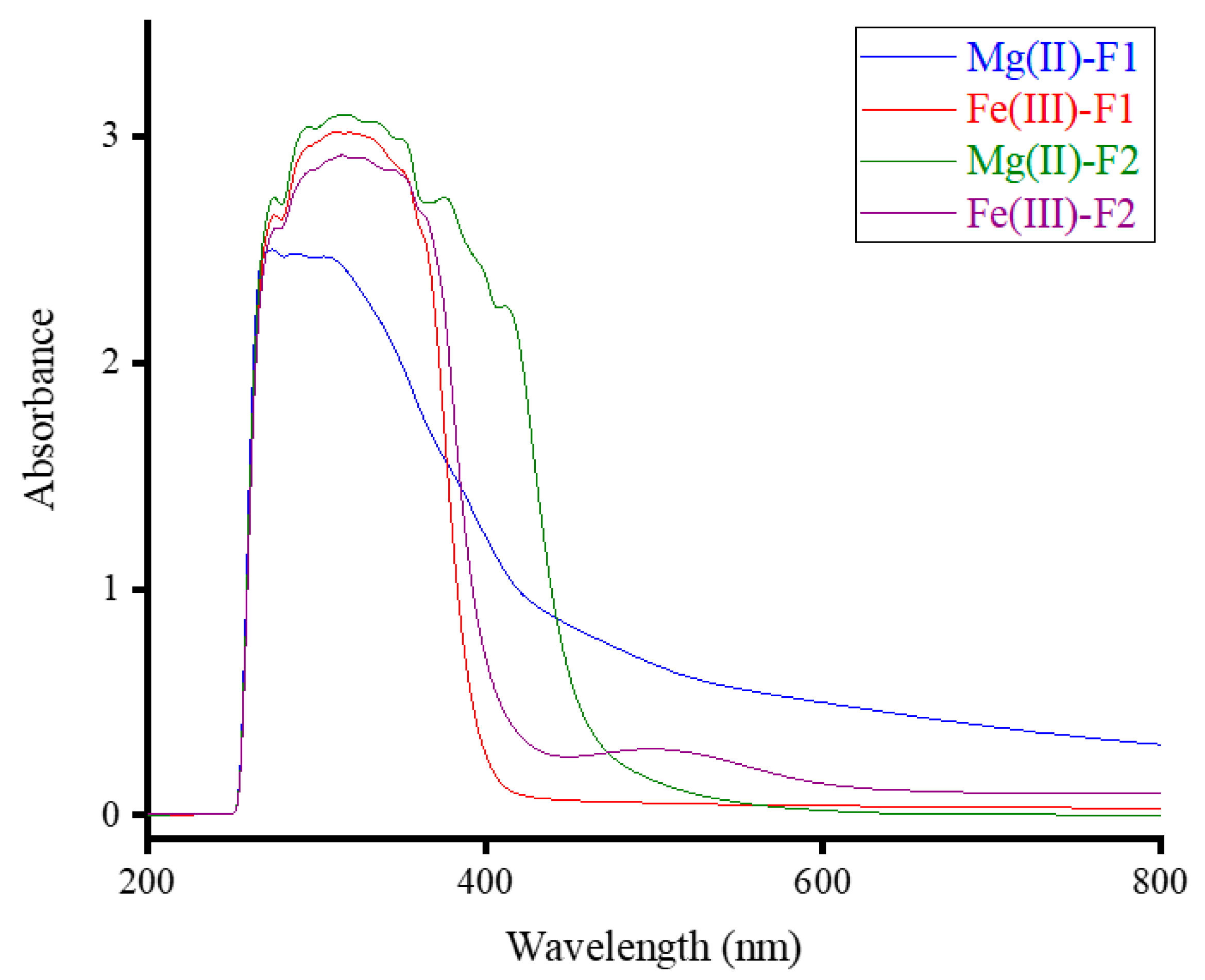


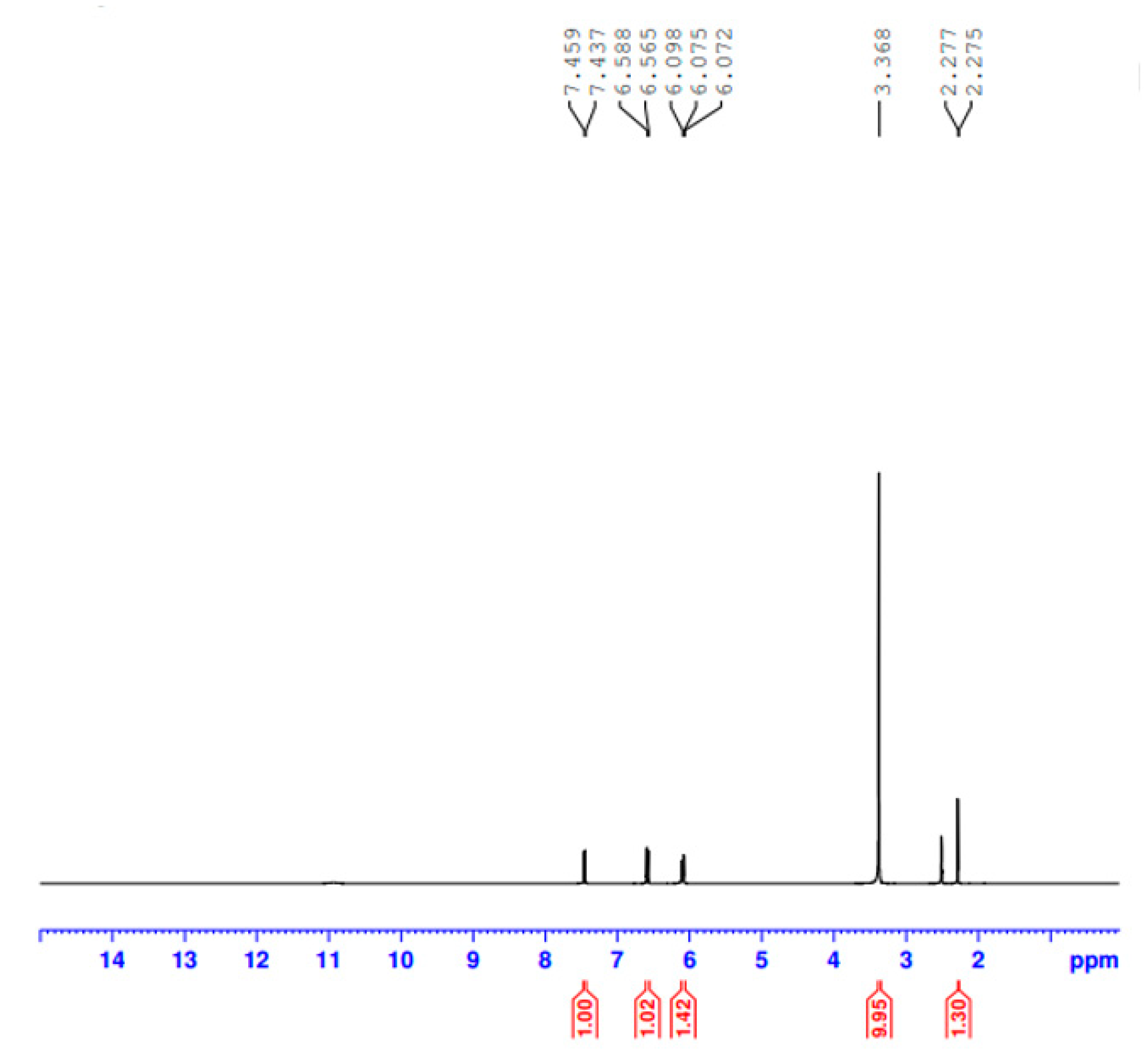
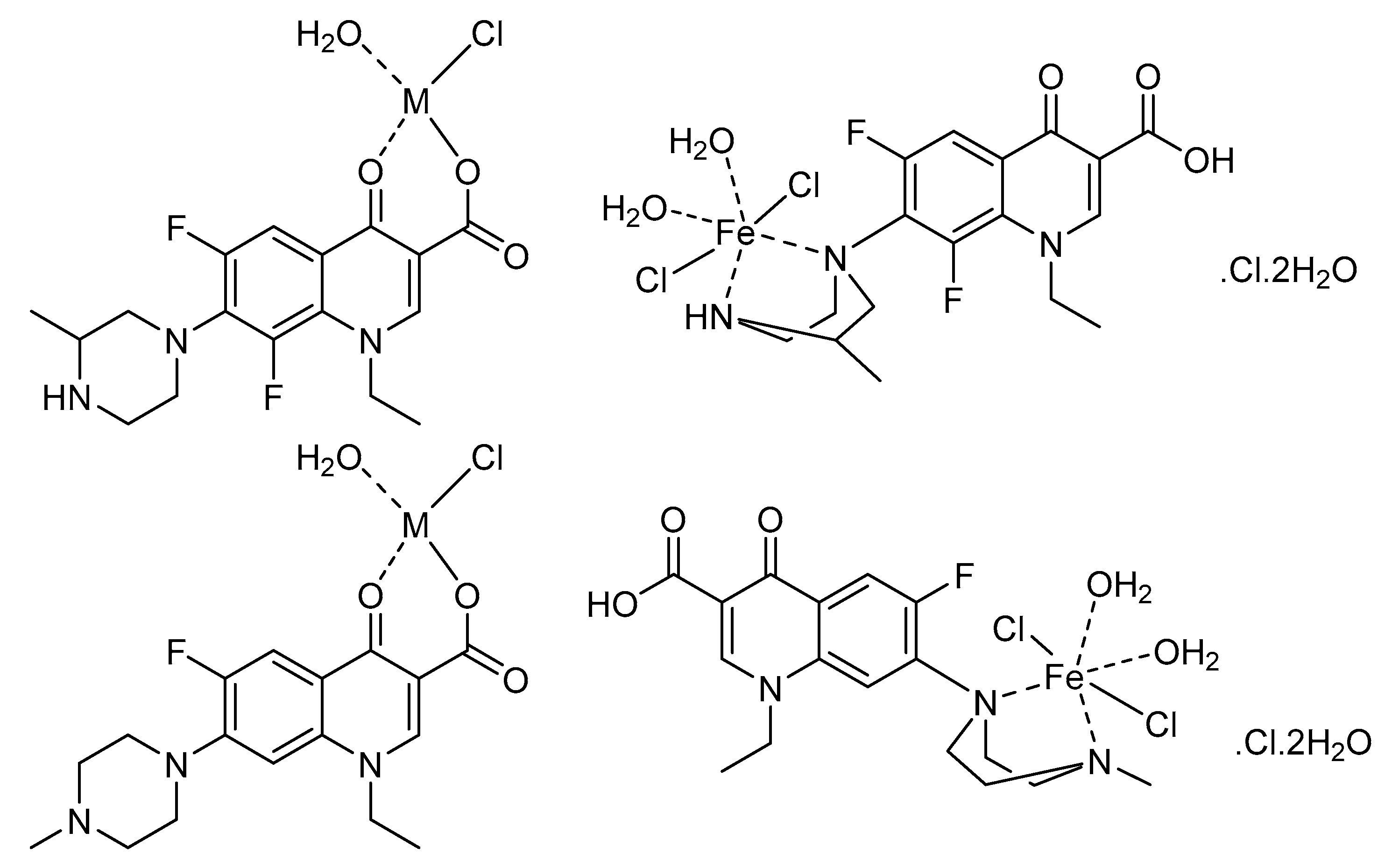
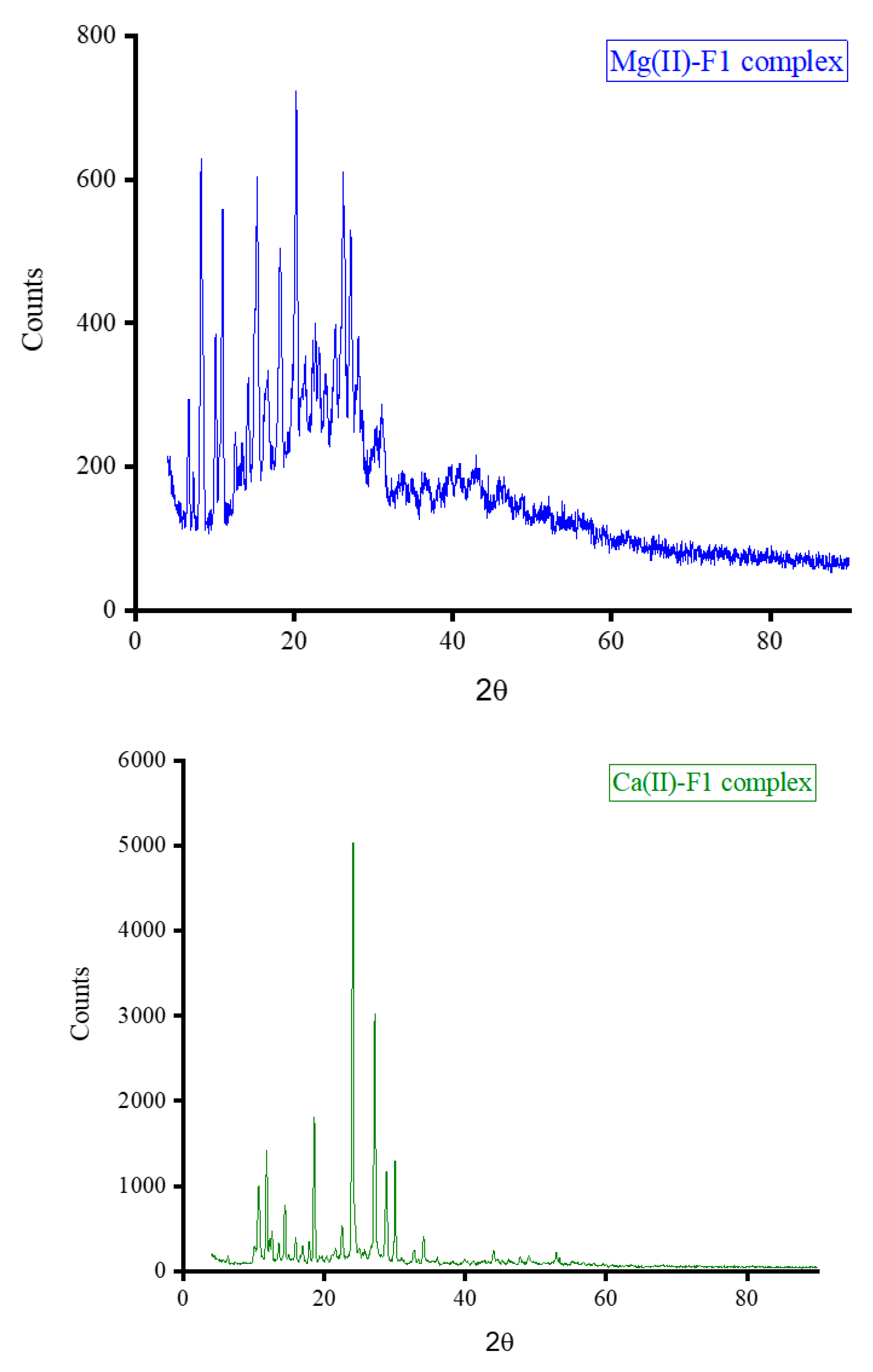
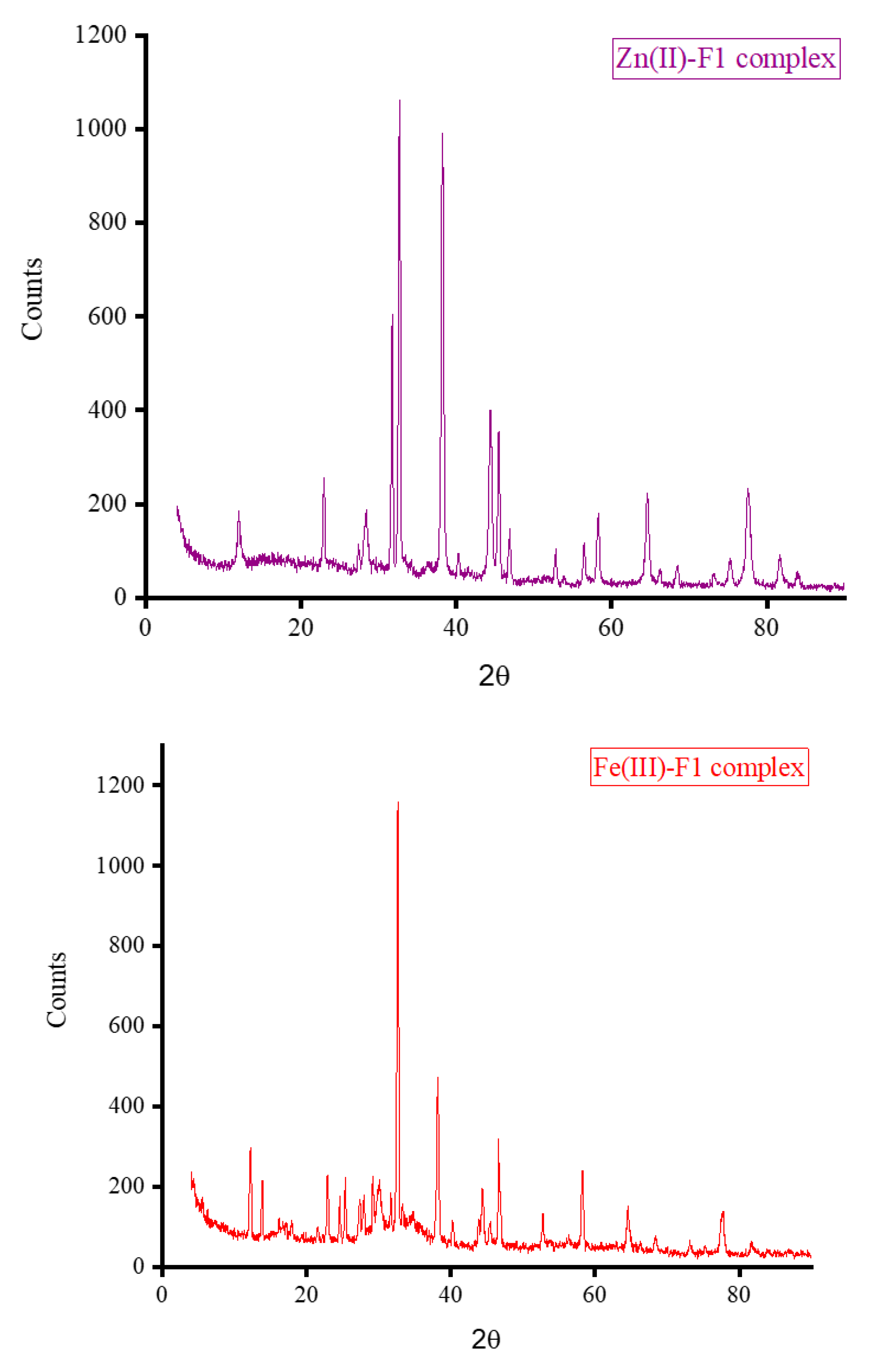
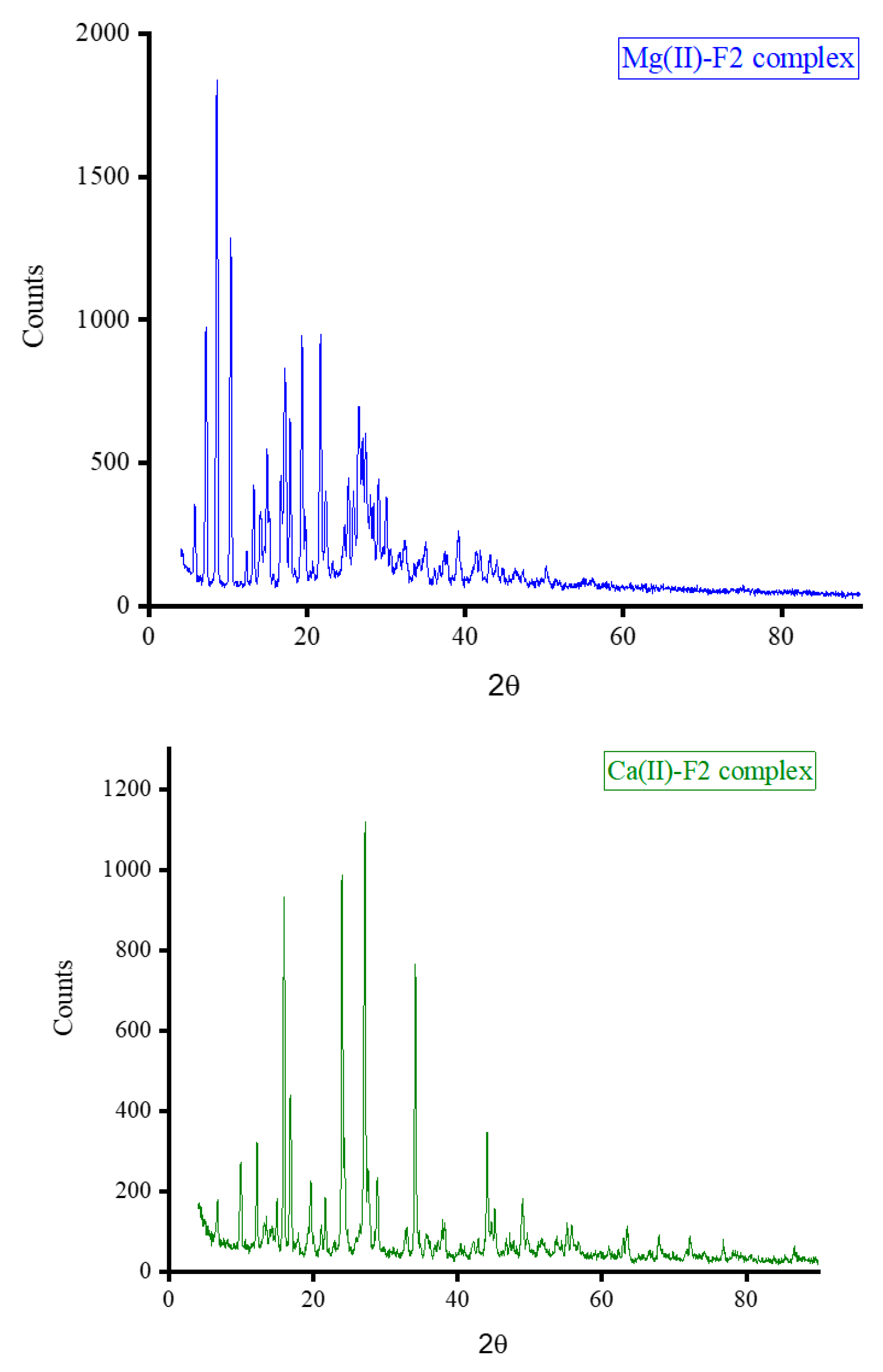
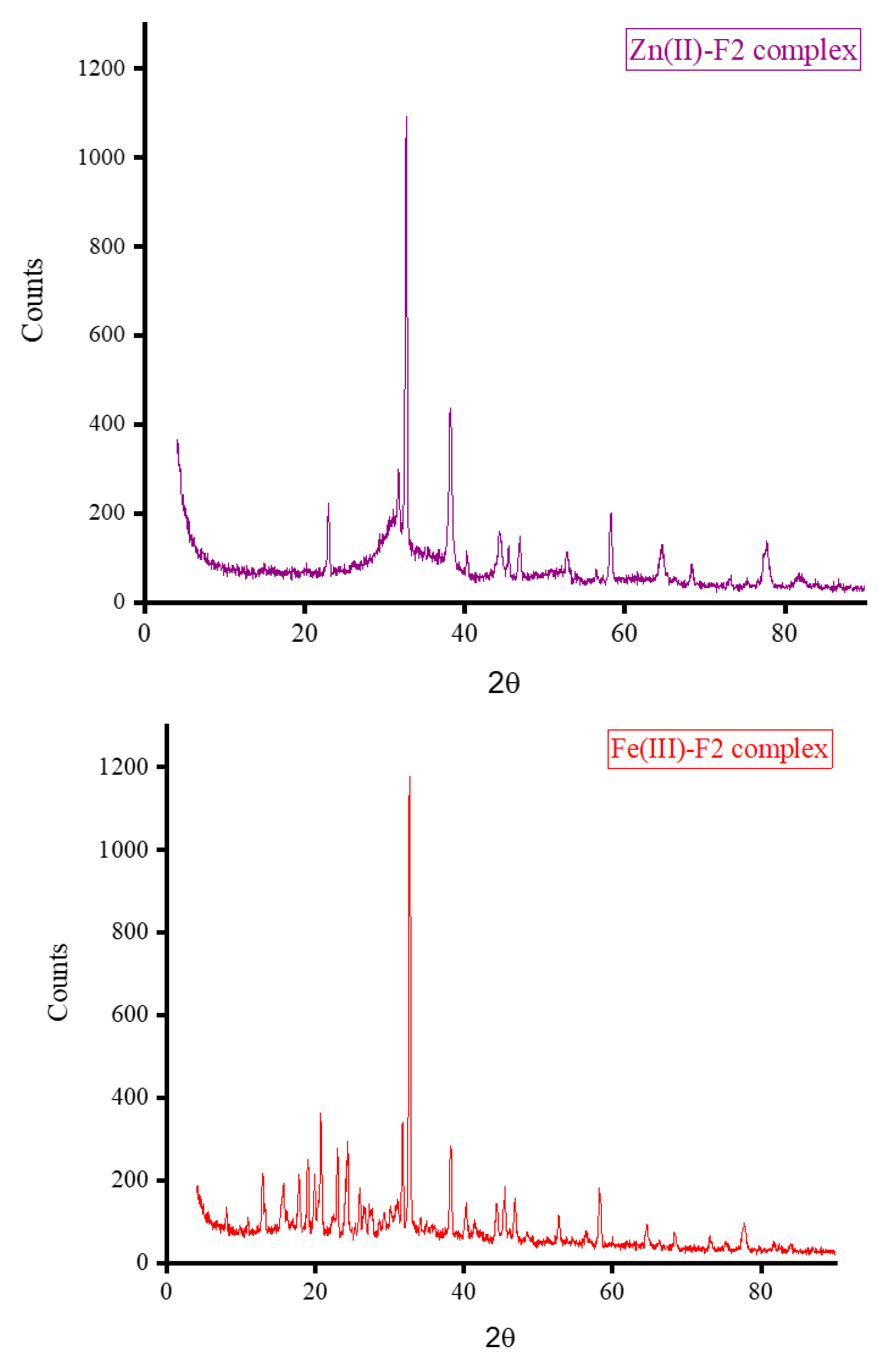
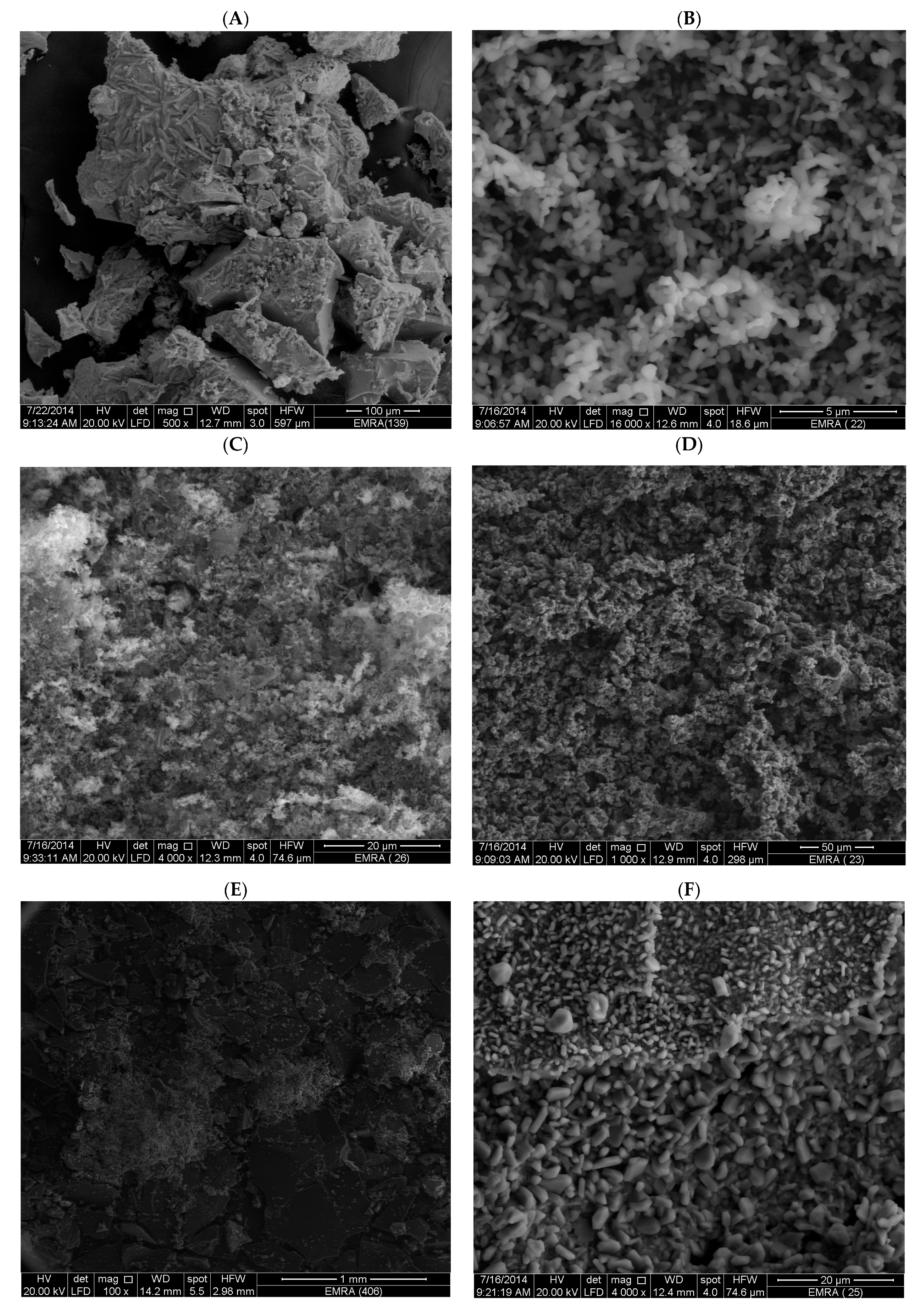
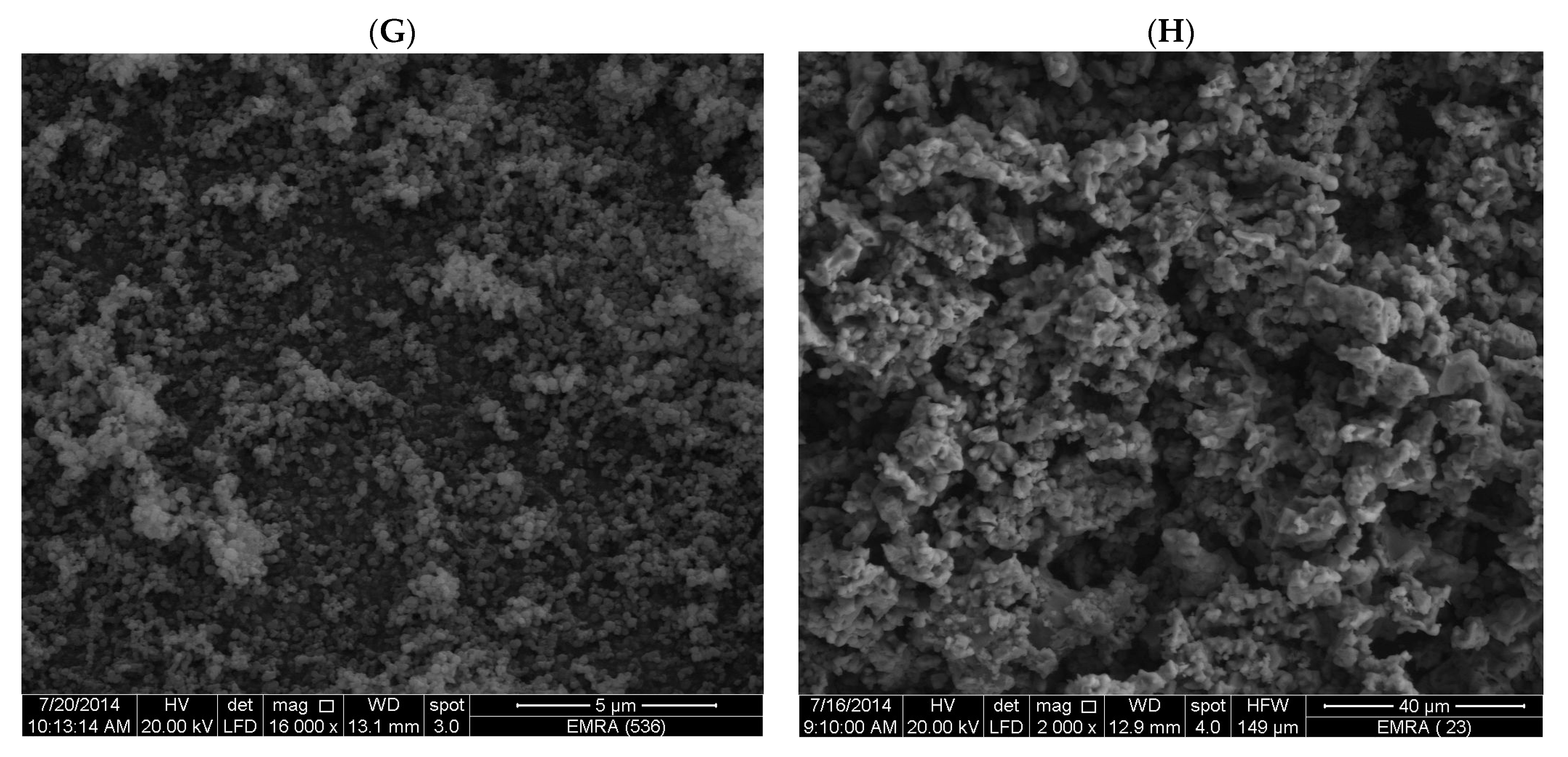
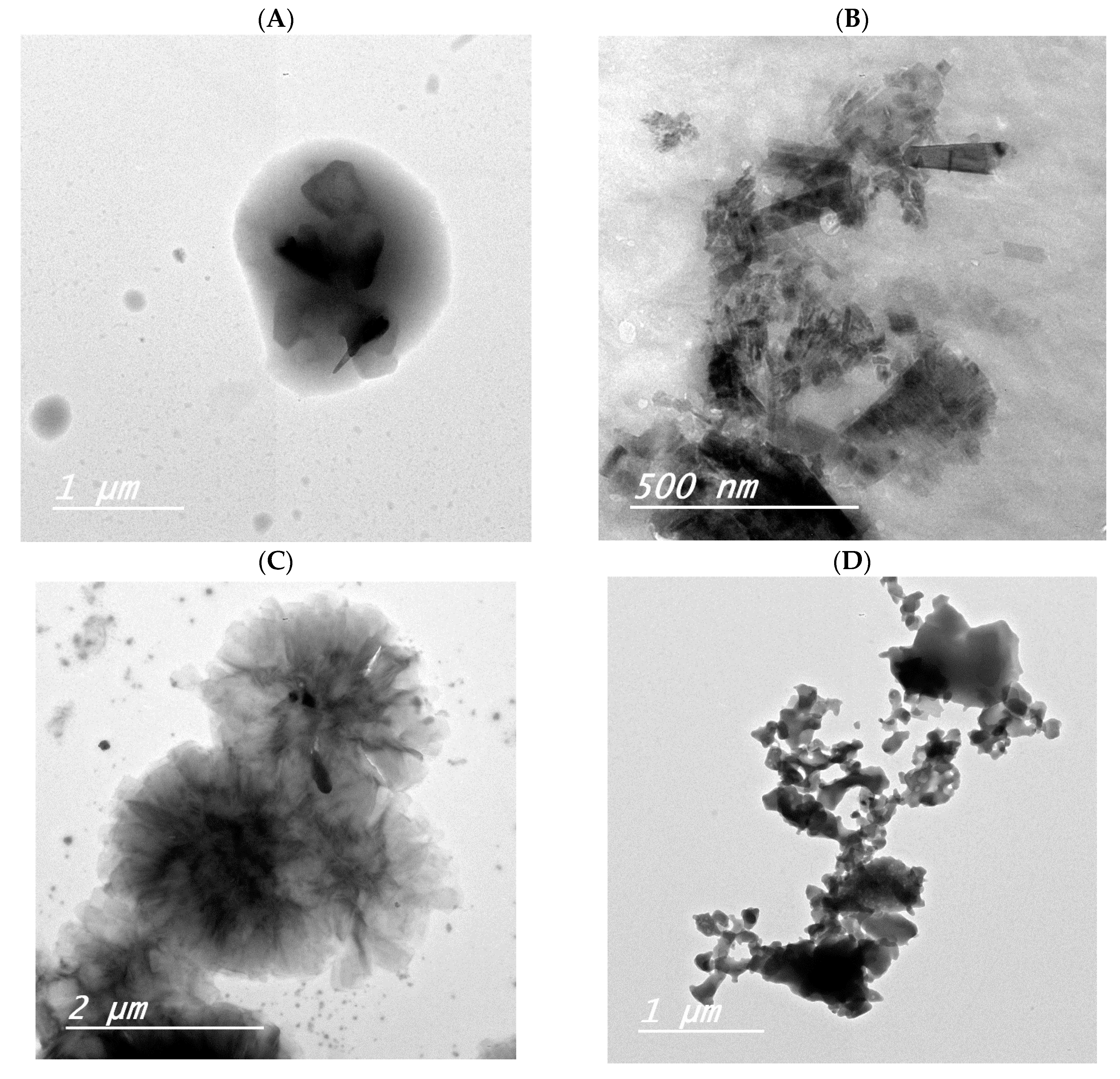
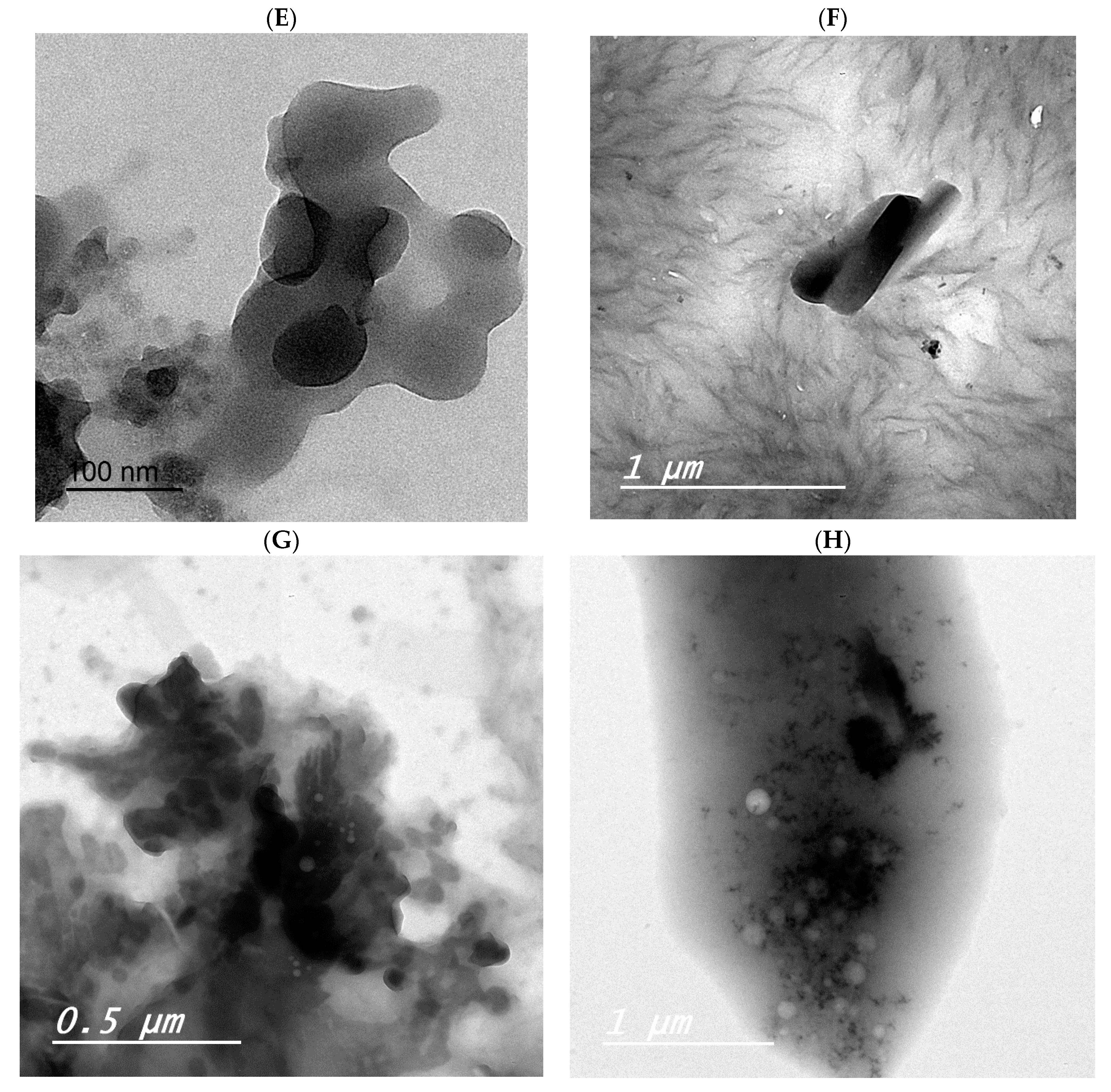
| Drug | Molar Ratio (Metal to Ligand) | Complexes | References |
|---|---|---|---|
| F1 | 1:1 | [UO2F1(H2O)2](NO3)2 [thf1(H2O)4]Cl4 [znf1(H2O)4]Cl2 [cuf1(H2O)4]Cl2·2H2O [nif1(H2O)4]Cl2·H2O [cof1(H2O)4]Cl2 [fef1(H2O)4]Cl3·H2O [mnf1(H2O)4]Cl2 [crf1(H2O)4]Cl3 | [16,17,18] |
| 1:2 | [zro(F1)2Cl]Cl·15H2O [Y(F1)2Cl2]Cl·12H2O | ||
| 1:3 | [UO2(F1)3](NO3)2·4H2O [Bi(F1)3(H2O)2] | ||
| F2 | 1:1 | - | [16,19] |
| 1:2 | [Pt(F2)2] [Zn(F2)2(H2O)]·2H2O | ||
| 1:3 | [Bi(F2)3(H2O)2] |
| Microbe | Abbreviation |
|---|---|
| (A) Gram-positive bacterial strains | |
| Bacillus subtilis | B. subtilis |
| Streptococcus pneumoniae | S. pneumoniae |
| Staphylococcus aureus | S. aureus |
| (B) Gram-negative bacterial strains | |
| Escherichia coli | E. coli |
| Pseudomonas aeruginosa | P. aeruginosa |
| (C) Fungal strains | |
| Aspergillus niger | A. niger |
| Penicillium sp. | - |
| Candida albicans | C. albicans |
| Complex | Elemental Results (%) Found (Calculated) | |||||
|---|---|---|---|---|---|---|
| C | H | N | Cl | H2O | Metal | |
| Mg(II)-F1 | 44.06 (43.95) | 5.35 (5.17) | 8.93 (9.05) | 7.50 (7.64) | 11.45 (11.63) | 5.46 (5.24) |
| Ca(II)-F1 | 40.73 (40.97) | 5.10 (5.22) | 8.59 (8.44) | 7.30 (7.12) | 14.62 (14.46) | 7.94 (8.05) |
| Zn(II)-F1 | 43.60 (43.48) | 4.18 (4.26) | 9.10 (8.95) | 7.43 (7.56) | 4.00 (3.84) | 13.70 (13.93) |
| Fe(III)-F1 | 34.96 (34.84) | 4.31 (4.61) | 7.30 (7.17) | 17.94 (18.16) | 12.09 (12.30) | 9.43 (9.54) |
| Mg(II)-F2 | 45.60 (45.73) | 5.76 (5.60) | 9.57 (9.41) | 7.80 (7.95) | 12.32 (12.10) | 5.70 (5.45) |
| Ca(II)-F2 | 42.39 (42.51) | 5.99 (5.83) | 8.86 (8.75) | 7.56 (7.39) | 14.77 (15.00) | 8.26 (8.35) |
| Zn(II)-F2 | 45.35 (45.21) | 4.79 (4.88) | 9.45 (9.31) | 7.70 (7.86) | 3.92 (3.99) | 14.62 (14.49) |
| Fe(III)-F2 | 35.70 (35.94) | 5.00 (5.11) | 7.22 (7.40) | 18.95 (18.74) | 12.85 (12.69) | 9.97 (9.84) |
| Free F1 | F1-Zn(II) | Assignments |
|---|---|---|
| 1.32–1.76 | 2.27, 2.28 | δ 3H, −CH3, −CH2CH3 δ 3H, −CH3; attached to piperazine ring |
| 3.55–4.21 | 6.07, 6.08, 6.98 | δ 7H; piperazine ring protons |
| 4.63–4.69 | 6.57, 6.59 | δ 2H, −CH2, −CH2CH3 |
| 7.79, 8.90 | 7.44, 7.46 | δ H, -CH; benzene ring and pyridine ring |
| 10.19–10.31 | - | δ H, −NH2+; piperazine ring |
| 11.78 | - | δ H, −COOH |
| Sample | Gram-Positive Bacteria Strains | Gram-Negative Bacteria Strains | |||
|---|---|---|---|---|---|
| B. subtilis | S. pneumoniae | S. aureus | E. coli | P. aeruginosa | |
| DMSO (−control) | 0.0 | 0.0 | 0.0 | 0.0 | 0.0 |
| Streptomycin (+control) | 18.0 | 17.0 | 20.0 | 22.0 | 27.0 |
| Mg(II)-F1 | 6.0 | 1.0 | 2.0 | 5.0 | 4.0 |
| Ca(II)-F1 | 5.0 | 3.0 | 8.0 | 2.0 | 8.0 |
| Zn(II)-F1 | 9.0 | 5.0 | 12.0 | 7.0 | 3.0 |
| Fe(III)-F1 | 16.0 | 19.0 | 21.0 | 19.0 | 24.0 |
| Mg(II)-F2 | 18.0 | 20.0 | 17.0 | 20.0 | 18.0 |
| Ca(II)-F2 | 10.0 | 15.0 | 16.0 | 14.0 | 19.0 |
| Zn(II)-F2 | 8.0 | 11.0 | 18.0 | 20.0 | 24.0 |
| Fe(III)-F2 | 4.0 | 13.0 | 5.0 | 13.0 | 14.0 |
| Sample | Fungal Strains | ||
|---|---|---|---|
| A. niger | Penicillium sp. | C. albicans | |
| DMSO (−control) | 0.0 | 0.0 | 0.0 |
| Ketoconazole (+control) | 18.0 | 21.0 | 21.0 |
| Mg(II)-F1 | 2.0 | 3.0 | 1.0 |
| Ca(II)-F1 | 5.0 | 7.0 | 1.0 |
| Zn(II)-F1 | 5.0 | 9.0 | 7.0 |
| Fe(II)-F1 | 19.0 | 23.0 | 21.0 |
| Mg(II)-F2 | 11.0 | 17.0 | 18.0 |
| Ca(II)-F2 | 9.0 | 11.0 | 15.0 |
| Zn(II)-F2 | 15.0 | 18.0 | 17.0 |
| Fe(III)-F2 | 11.0 | 13.0 | 12.0 |
Disclaimer/Publisher’s Note: The statements, opinions and data contained in all publications are solely those of the individual author(s) and contributor(s) and not of MDPI and/or the editor(s). MDPI and/or the editor(s) disclaim responsibility for any injury to people or property resulting from any ideas, methods, instructions or products referred to in the content. |
© 2023 by the authors. Licensee MDPI, Basel, Switzerland. This article is an open access article distributed under the terms and conditions of the Creative Commons Attribution (CC BY) license (https://creativecommons.org/licenses/by/4.0/).
Share and Cite
Almehizia, A.A.; Al-Omar, M.A.; Naglah, A.M.; Bhat, M.A.; Eskandrani, R.; Alotaibi, F.A.; Refat, M.S.; Adam, A.M.A. Preparation, Characterization, and In Vitro Evaluation of the Biological Activity of Several Metal-Based Complexes with Two Widely Used Fluoroquinolone Antibiotics: Lomefloxacin and Pefloxacin Drugs. Crystals 2023, 13, 1078. https://doi.org/10.3390/cryst13071078
Almehizia AA, Al-Omar MA, Naglah AM, Bhat MA, Eskandrani R, Alotaibi FA, Refat MS, Adam AMA. Preparation, Characterization, and In Vitro Evaluation of the Biological Activity of Several Metal-Based Complexes with Two Widely Used Fluoroquinolone Antibiotics: Lomefloxacin and Pefloxacin Drugs. Crystals. 2023; 13(7):1078. https://doi.org/10.3390/cryst13071078
Chicago/Turabian StyleAlmehizia, Abdulrahman A., Mohamed A. Al-Omar, Ahmed M. Naglah, Mashooq A. Bhat, Razan Eskandrani, Fatimah A. Alotaibi, Moamen S. Refat, and Abdel Majid A. Adam. 2023. "Preparation, Characterization, and In Vitro Evaluation of the Biological Activity of Several Metal-Based Complexes with Two Widely Used Fluoroquinolone Antibiotics: Lomefloxacin and Pefloxacin Drugs" Crystals 13, no. 7: 1078. https://doi.org/10.3390/cryst13071078







